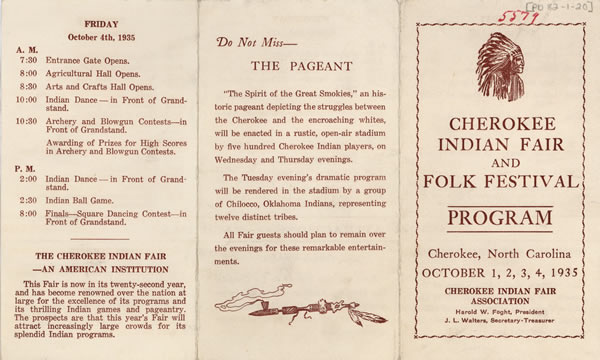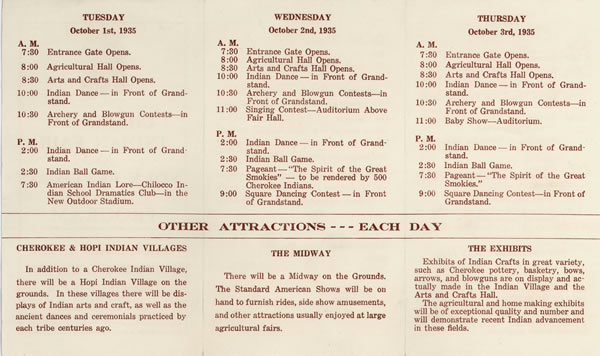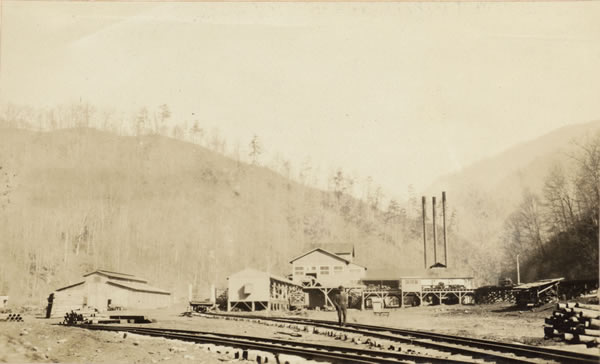Travel Western North Carolina
Motoring through the Mountains - 1930s: Cherokee

Cherokee Fall Fair (Courtesy of the Sylva Herald, Sylva, N.C.)
 Front of Program for the 1935 Cherokee Indian Fair
Front of Program for the 1935 Cherokee Indian Fair

Back of Program for the 1935 Cherokee Indian Fair
In 1914 the Eastern Band of Cherokee Indians began to hold a fall fair and festival that highlighted agricultural produce, craftsmanship, cultural events, and entertainment. Local newspapers regularly printed articles on the fair’s activities. This program for the Cherokee Indian Fair and Folk Festival, held October 1 – October 4, 1935, urged attendees to also see a pageant, “The Spirit of the Great Smokies.” The Ruralite (Sylva, N.C.) for October 8, 1935, ran this article about the fair, noting that, “It was announced on the closing day of the fair that half of the automobiles that entered the fair grounds here were from outside the state.”
The popularity of an automobile trip to Cherokee had been mentioned by travelers for years. In an article entitled “Motor-Coaching through North Carolina,” published in the May 1926 National Geographic Magazine, the author commented on a trip from Asheville to Cherokee. As the writer noted, the “75-mile stretch of ideal motor-coaching up the foaming course of the Tuckasegee River took us past the big paper-pulp and acid-wood plants to the Cherokee Indian Reservation at the foot of the Great Smoky Mountains.” The “big paper-pulp and acid-wood plants” referred to in the article would be the Champion Fibre Corporation’s operations in Canton, N.C.. The American Enka Company, which was located in the Enka-Candler, N.C., area and manufactured rayon, was not in operation until 1929, three years after this article was written. This same article included pictures by George Masa, the noted photographer based in Asheville who documented the area and helped bring the potentials of a Great Smoky Mountains National Park to public attention.
Click the Ruralite article or the Festival program pages for a larger view.
The logging community of Smokemont, near Cherokee, was part of the Champion Fibre Corporation’s extensive land holdings and its operations in western North Carolina. To help provide the wood necessary to operate its paper and pulp plant at Canton, N.C., the company maintained a sawmill at Smokemont. In the early 1920s, this sawmill furnished 45,000 feet of lumber a day and an equal amount of pulp wood. In the early 1930s this area would become part of the Great Smoky Mountains National Park. By 1939 the Federal Writer’s Project-produced book North Carolina: A Guide to the Old North State listed as Smokemont as “an abandoned lumber village” which was “being converted into a tourist center.”
 |
Return to the Map for the 1930s
Sources & Readings
- Chiltoskey, Mary Ulmer. Cherokee Fair & Festival: A History thru 1978 (1995 Supplement Included). [Cherokee?, N.C.]: The Association [1996?] (Asheville, N.C. : Gilbert Printing).
- Finger, John R. Cherokee Americans: The Eastern Band of Cherokees in the Twentieth Century. Lincoln: University of Nebraska Press, 1991.
- Frome, Michael. Strangers in High Places: The Story of the Great Smoky Mountains. Expanded ed. Knoxville: University of Tennessee Press, 1994.
- “Indian Festival May Be Held in Tourist Season.” The Ruralite (Sylva, N.C.), October 8, 1935.
- Pierce, Daniel S. Logging in the Smokies. Gatlinburg, Tenn.: Great Smoky Mountains Association, 2003.
